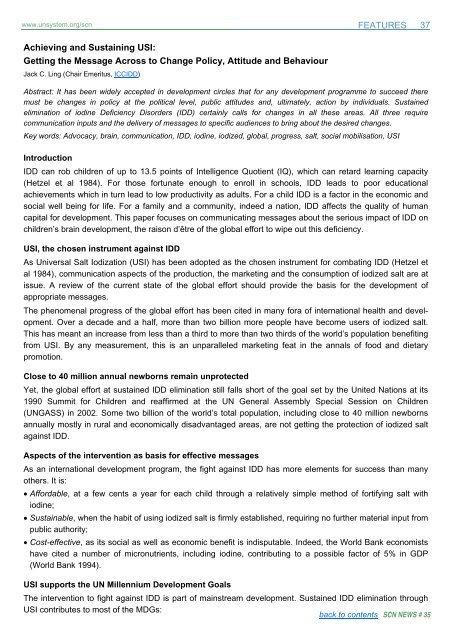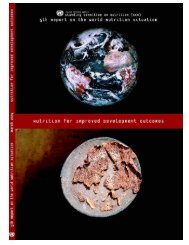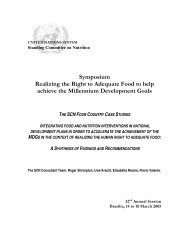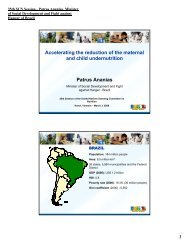Universal Salt Iodization (USI) - FTP Directory Listing
Universal Salt Iodization (USI) - FTP Directory Listing
Universal Salt Iodization (USI) - FTP Directory Listing
- No tags were found...
You also want an ePaper? Increase the reach of your titles
YUMPU automatically turns print PDFs into web optimized ePapers that Google loves.
www.unsystem.org/scn FEATURES 37Achieving and Sustaining <strong>USI</strong>:Getting the Message Across to Change Policy, Attitude and BehaviourJack C. Ling (Chair Emeritus, ICCIDD)Abstract: It has been widely accepted in development circles that for any development programme to succeed theremust be changes in policy at the political level, public attitudes and, ultimately, action by individuals. Sustainedelimination of iodine Deficiency Disorders (IDD) certainly calls for changes in all these areas. All three requirecommunication inputs and the delivery of messages to specific audiences to bring about the desired changes.Key words: Advocacy, brain, communication, IDD, iodine, iodized, global, progress, salt, social mobilisation, <strong>USI</strong>IntroductionIDD can rob children of up to 13.5 points of Intelligence Quotient (IQ), which can retard learning capacity(Hetzel et al 1984). For those fortunate enough to enroll in schools, IDD leads to poor educationalachievements which in turn lead to low productivity as adults. For a child IDD is a factor in the economic andsocial well being for life. For a family and a community, indeed a nation, IDD affects the quality of humancapital for development. This paper focuses on communicating messages about the serious impact of IDD onchildren’s brain development, the raison d’être of the global effort to wipe out this deficiency.<strong>USI</strong>, the chosen instrument against IDDAs <strong>Universal</strong> <strong>Salt</strong> <strong>Iodization</strong> (<strong>USI</strong>) has been adopted as the chosen instrument for combating IDD (Hetzel etal 1984), communication aspects of the production, the marketing and the consumption of iodized salt are atissue. A review of the current state of the global effort should provide the basis for the development ofappropriate messages.The phenomenal progress of the global effort has been cited in many fora of international health and development.Over a decade and a half, more than two billion more people have become users of iodized salt.This has meant an increase from less than a third to more than two thirds of the world’s population benefitingfrom <strong>USI</strong>. By any measurement, this is an unparalleled marketing feat in the annals of food and dietarypromotion.Close to 40 million annual newborns remain unprotectedYet, the global effort at sustained IDD elimination still falls short of the goal set by the United Nations at its1990 Summit for Children and reaffirmed at the UN General Assembly Special Session on Children(UNGASS) in 2002. Some two billion of the world’s total population, including close to 40 million newbornsannually mostly in rural and economically disadvantaged areas, are not getting the protection of iodized saltagainst IDD.Aspects of the intervention as basis for effective messagesAs an international development program, the fight against IDD has more elements for success than manyothers. It is:• Affordable, at a few cents a year for each child through a relatively simple method of fortifying salt withiodine;• Sustainable, when the habit of using iodized salt is firmly established, requiring no further material input frompublic authority;• Cost-effective, as its social as well as economic benefit is indisputable. Indeed, the World Bank economistshave cited a number of micronutrients, including iodine, contributing to a possible factor of 5% in GDP(World Bank 1994).<strong>USI</strong> supports the UN Millennium Development GoalsThe intervention to fight against IDD is part of mainstream development. Sustained IDD elimination through<strong>USI</strong> contributes to most of the MDGs:back to contents SCN NEWS # 35







